Homicide Case Study: Examining Criminal Negligence and NSW Law
VerifiedAdded on 2023/06/07
|9
|2410
|386
Case Study
AI Summary
This case study delves into the complexities of a negligent homicide case, analyzing the criminal liability of an individual under NSW law, particularly concerning the Crimes Act 1900. The scenario involves Bobbi, a lawyer who contracts Ebola in the Democratic Republic of Congo and, against medical advice, returns to Sydney and breastfeeds her baby, leading to the baby's death. The analysis explores the elements of homicide, distinguishing between voluntary and involuntary manslaughter, and focuses on whether Bobbi's actions constitute negligent manslaughter. It examines the legal concepts of actus reus (the physical act) and mens rea (the intention), arguing that while Bobbi may not have had direct intent, her negligence and recklessness in disregarding medical advice and potentially exposing her child to the virus make her liable. The study also considers relevant sections of the Crimes Act 1900, including those related to murder, manslaughter, and offshore offenses, ultimately concluding that Bobbi could be found guilty of both negligent homicide and voluntary manslaughter due to her awareness of the risks and her subsequent actions. Desklib provides a platform to access more solved assignments and study resources for students.
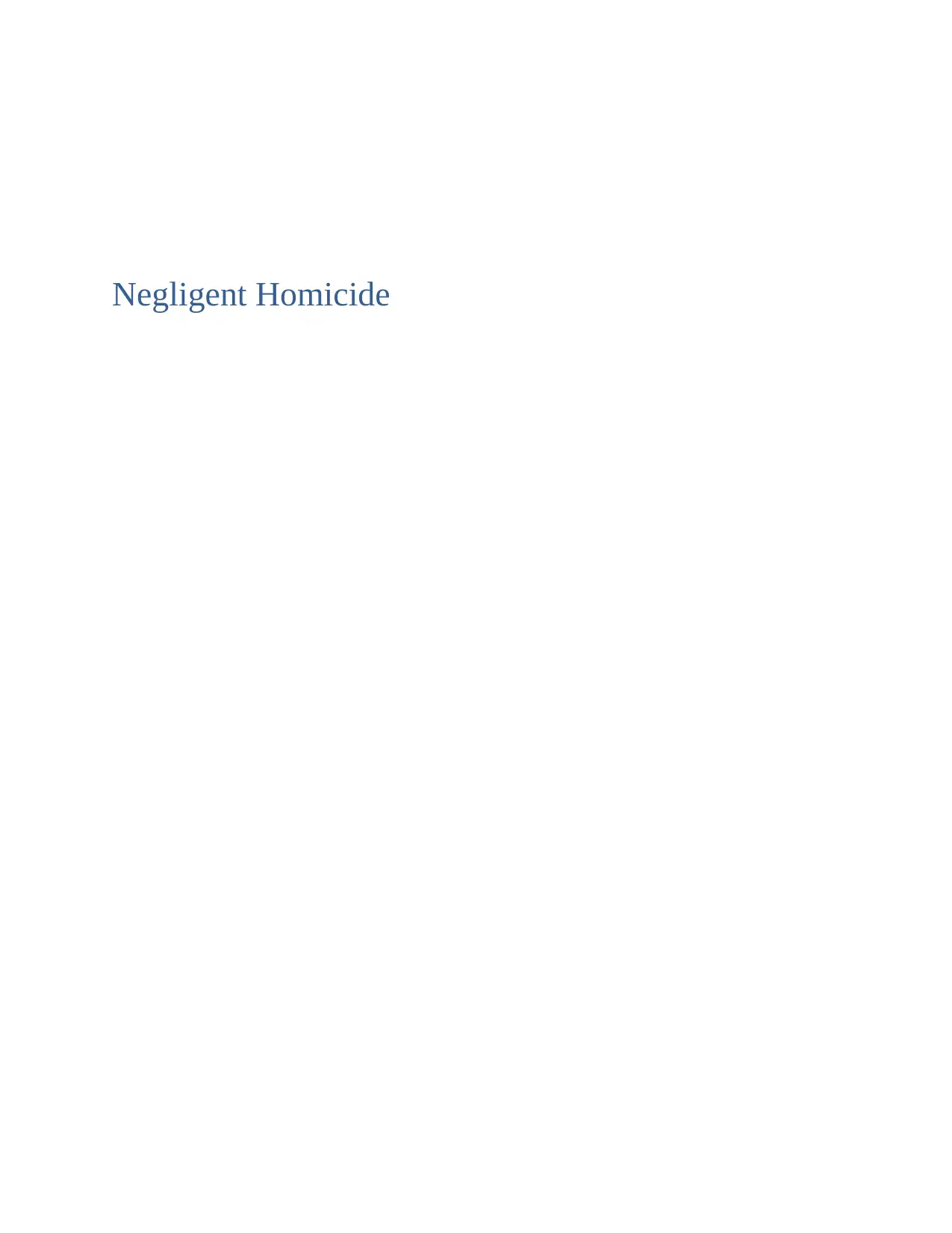
Negligent Homicide
Paraphrase This Document
Need a fresh take? Get an instant paraphrase of this document with our AI Paraphraser
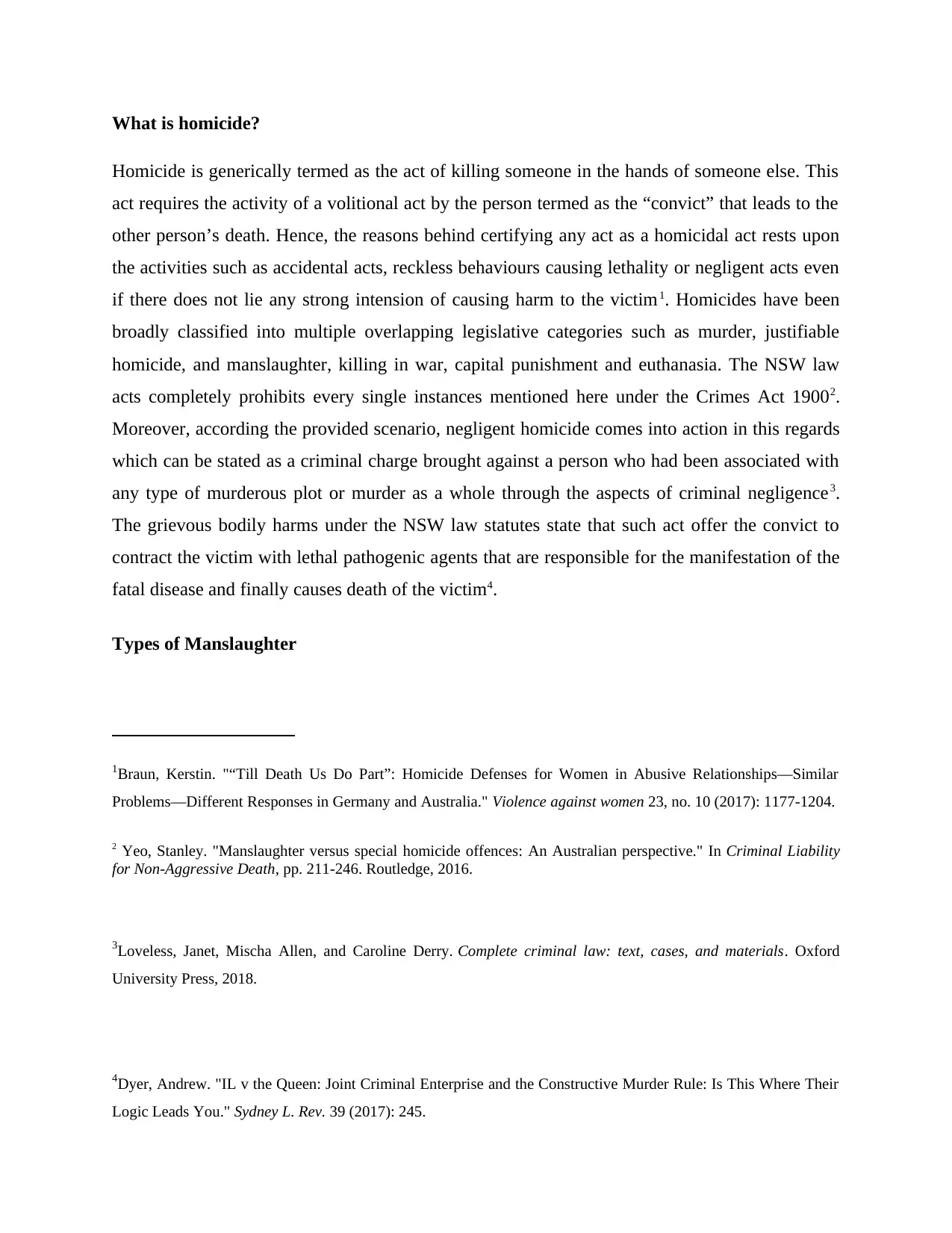
What is homicide?
Homicide is generically termed as the act of killing someone in the hands of someone else. This
act requires the activity of a volitional act by the person termed as the “convict” that leads to the
other person’s death. Hence, the reasons behind certifying any act as a homicidal act rests upon
the activities such as accidental acts, reckless behaviours causing lethality or negligent acts even
if there does not lie any strong intension of causing harm to the victim1. Homicides have been
broadly classified into multiple overlapping legislative categories such as murder, justifiable
homicide, and manslaughter, killing in war, capital punishment and euthanasia. The NSW law
acts completely prohibits every single instances mentioned here under the Crimes Act 19002.
Moreover, according the provided scenario, negligent homicide comes into action in this regards
which can be stated as a criminal charge brought against a person who had been associated with
any type of murderous plot or murder as a whole through the aspects of criminal negligence3.
The grievous bodily harms under the NSW law statutes state that such act offer the convict to
contract the victim with lethal pathogenic agents that are responsible for the manifestation of the
fatal disease and finally causes death of the victim4.
Types of Manslaughter
1Braun, Kerstin. "“Till Death Us Do Part”: Homicide Defenses for Women in Abusive Relationships—Similar
Problems—Different Responses in Germany and Australia." Violence against women 23, no. 10 (2017): 1177-1204.
2 Yeo, Stanley. "Manslaughter versus special homicide offences: An Australian perspective." In Criminal Liability
for Non-Aggressive Death, pp. 211-246. Routledge, 2016.
3Loveless, Janet, Mischa Allen, and Caroline Derry. Complete criminal law: text, cases, and materials. Oxford
University Press, 2018.
4Dyer, Andrew. "IL v the Queen: Joint Criminal Enterprise and the Constructive Murder Rule: Is This Where Their
Logic Leads You." Sydney L. Rev. 39 (2017): 245.
Homicide is generically termed as the act of killing someone in the hands of someone else. This
act requires the activity of a volitional act by the person termed as the “convict” that leads to the
other person’s death. Hence, the reasons behind certifying any act as a homicidal act rests upon
the activities such as accidental acts, reckless behaviours causing lethality or negligent acts even
if there does not lie any strong intension of causing harm to the victim1. Homicides have been
broadly classified into multiple overlapping legislative categories such as murder, justifiable
homicide, and manslaughter, killing in war, capital punishment and euthanasia. The NSW law
acts completely prohibits every single instances mentioned here under the Crimes Act 19002.
Moreover, according the provided scenario, negligent homicide comes into action in this regards
which can be stated as a criminal charge brought against a person who had been associated with
any type of murderous plot or murder as a whole through the aspects of criminal negligence3.
The grievous bodily harms under the NSW law statutes state that such act offer the convict to
contract the victim with lethal pathogenic agents that are responsible for the manifestation of the
fatal disease and finally causes death of the victim4.
Types of Manslaughter
1Braun, Kerstin. "“Till Death Us Do Part”: Homicide Defenses for Women in Abusive Relationships—Similar
Problems—Different Responses in Germany and Australia." Violence against women 23, no. 10 (2017): 1177-1204.
2 Yeo, Stanley. "Manslaughter versus special homicide offences: An Australian perspective." In Criminal Liability
for Non-Aggressive Death, pp. 211-246. Routledge, 2016.
3Loveless, Janet, Mischa Allen, and Caroline Derry. Complete criminal law: text, cases, and materials. Oxford
University Press, 2018.
4Dyer, Andrew. "IL v the Queen: Joint Criminal Enterprise and the Constructive Murder Rule: Is This Where Their
Logic Leads You." Sydney L. Rev. 39 (2017): 245.
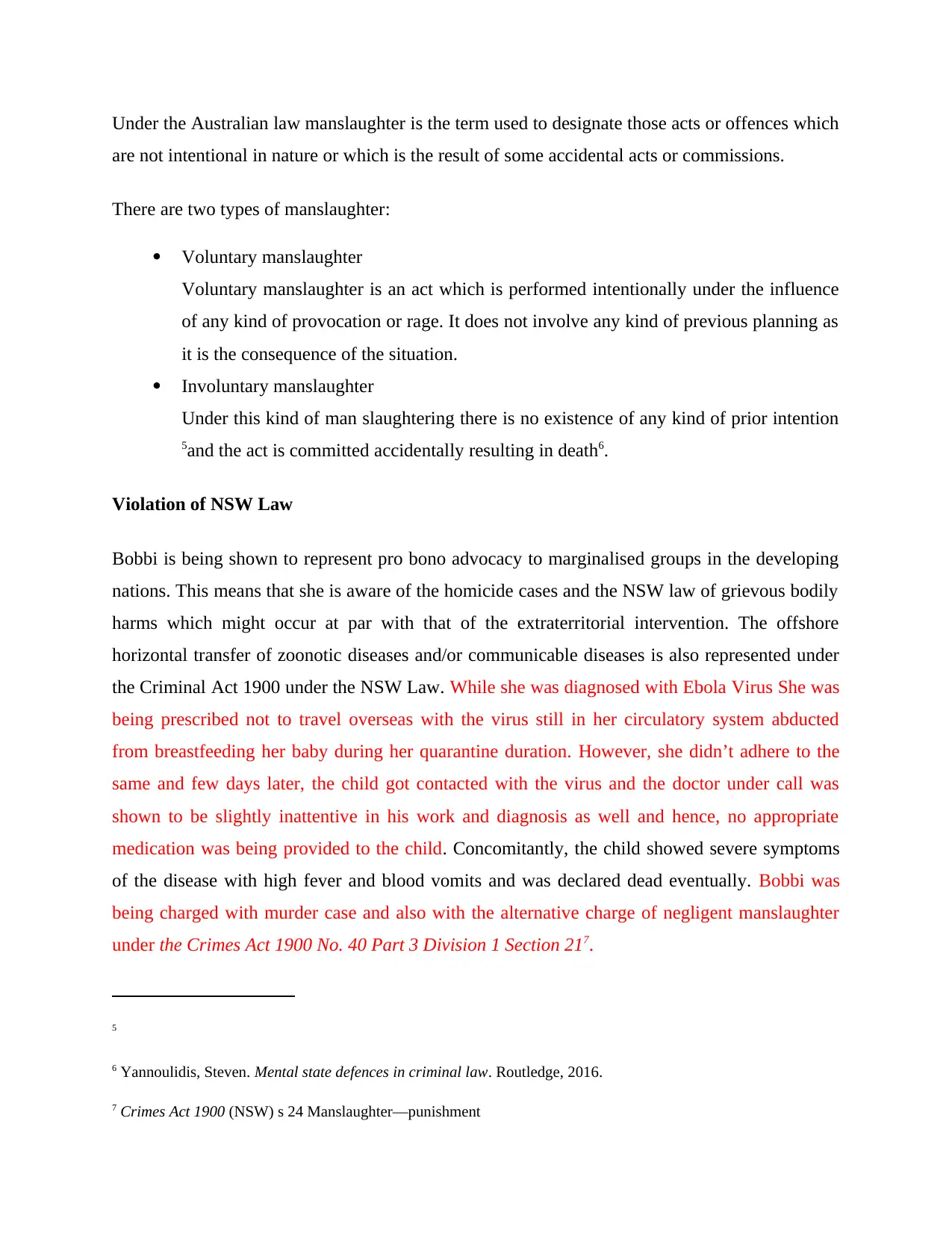
Under the Australian law manslaughter is the term used to designate those acts or offences which
are not intentional in nature or which is the result of some accidental acts or commissions.
There are two types of manslaughter:
Voluntary manslaughter
Voluntary manslaughter is an act which is performed intentionally under the influence
of any kind of provocation or rage. It does not involve any kind of previous planning as
it is the consequence of the situation.
Involuntary manslaughter
Under this kind of man slaughtering there is no existence of any kind of prior intention
5and the act is committed accidentally resulting in death6.
Violation of NSW Law
Bobbi is being shown to represent pro bono advocacy to marginalised groups in the developing
nations. This means that she is aware of the homicide cases and the NSW law of grievous bodily
harms which might occur at par with that of the extraterritorial intervention. The offshore
horizontal transfer of zoonotic diseases and/or communicable diseases is also represented under
the Criminal Act 1900 under the NSW Law. While she was diagnosed with Ebola Virus She was
being prescribed not to travel overseas with the virus still in her circulatory system abducted
from breastfeeding her baby during her quarantine duration. However, she didn’t adhere to the
same and few days later, the child got contacted with the virus and the doctor under call was
shown to be slightly inattentive in his work and diagnosis as well and hence, no appropriate
medication was being provided to the child. Concomitantly, the child showed severe symptoms
of the disease with high fever and blood vomits and was declared dead eventually. Bobbi was
being charged with murder case and also with the alternative charge of negligent manslaughter
under the Crimes Act 1900 No. 40 Part 3 Division 1 Section 217.
5
6 Yannoulidis, Steven. Mental state defences in criminal law. Routledge, 2016.
7 Crimes Act 1900 (NSW) s 24 Manslaughter—punishment
are not intentional in nature or which is the result of some accidental acts or commissions.
There are two types of manslaughter:
Voluntary manslaughter
Voluntary manslaughter is an act which is performed intentionally under the influence
of any kind of provocation or rage. It does not involve any kind of previous planning as
it is the consequence of the situation.
Involuntary manslaughter
Under this kind of man slaughtering there is no existence of any kind of prior intention
5and the act is committed accidentally resulting in death6.
Violation of NSW Law
Bobbi is being shown to represent pro bono advocacy to marginalised groups in the developing
nations. This means that she is aware of the homicide cases and the NSW law of grievous bodily
harms which might occur at par with that of the extraterritorial intervention. The offshore
horizontal transfer of zoonotic diseases and/or communicable diseases is also represented under
the Criminal Act 1900 under the NSW Law. While she was diagnosed with Ebola Virus She was
being prescribed not to travel overseas with the virus still in her circulatory system abducted
from breastfeeding her baby during her quarantine duration. However, she didn’t adhere to the
same and few days later, the child got contacted with the virus and the doctor under call was
shown to be slightly inattentive in his work and diagnosis as well and hence, no appropriate
medication was being provided to the child. Concomitantly, the child showed severe symptoms
of the disease with high fever and blood vomits and was declared dead eventually. Bobbi was
being charged with murder case and also with the alternative charge of negligent manslaughter
under the Crimes Act 1900 No. 40 Part 3 Division 1 Section 217.
5
6 Yannoulidis, Steven. Mental state defences in criminal law. Routledge, 2016.
7 Crimes Act 1900 (NSW) s 24 Manslaughter—punishment
⊘ This is a preview!⊘
Do you want full access?
Subscribe today to unlock all pages.

Trusted by 1+ million students worldwide
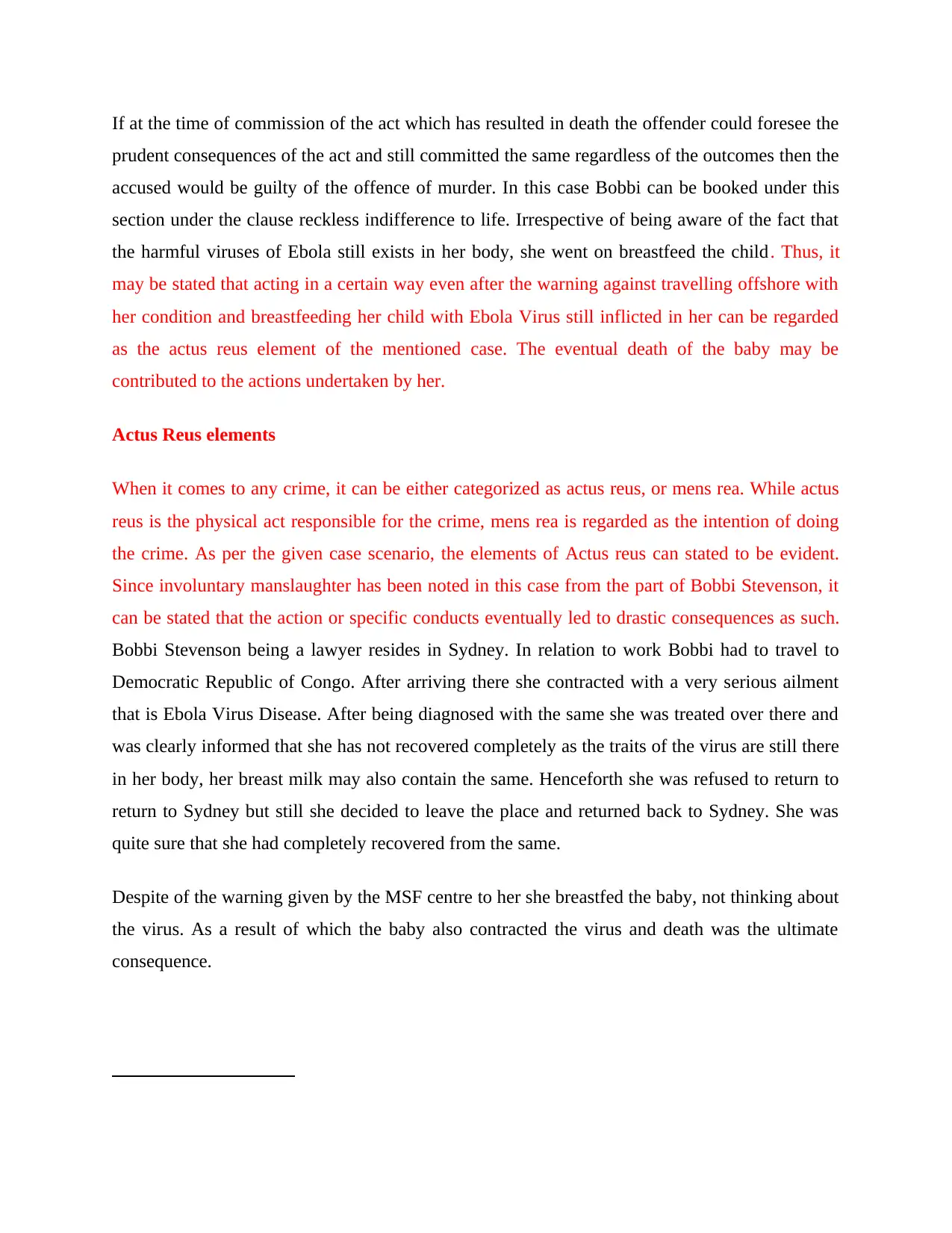
If at the time of commission of the act which has resulted in death the offender could foresee the
prudent consequences of the act and still committed the same regardless of the outcomes then the
accused would be guilty of the offence of murder. In this case Bobbi can be booked under this
section under the clause reckless indifference to life. Irrespective of being aware of the fact that
the harmful viruses of Ebola still exists in her body, she went on breastfeed the child. Thus, it
may be stated that acting in a certain way even after the warning against travelling offshore with
her condition and breastfeeding her child with Ebola Virus still inflicted in her can be regarded
as the actus reus element of the mentioned case. The eventual death of the baby may be
contributed to the actions undertaken by her.
Actus Reus elements
When it comes to any crime, it can be either categorized as actus reus, or mens rea. While actus
reus is the physical act responsible for the crime, mens rea is regarded as the intention of doing
the crime. As per the given case scenario, the elements of Actus reus can stated to be evident.
Since involuntary manslaughter has been noted in this case from the part of Bobbi Stevenson, it
can be stated that the action or specific conducts eventually led to drastic consequences as such.
Bobbi Stevenson being a lawyer resides in Sydney. In relation to work Bobbi had to travel to
Democratic Republic of Congo. After arriving there she contracted with a very serious ailment
that is Ebola Virus Disease. After being diagnosed with the same she was treated over there and
was clearly informed that she has not recovered completely as the traits of the virus are still there
in her body, her breast milk may also contain the same. Henceforth she was refused to return to
return to Sydney but still she decided to leave the place and returned back to Sydney. She was
quite sure that she had completely recovered from the same.
Despite of the warning given by the MSF centre to her she breastfed the baby, not thinking about
the virus. As a result of which the baby also contracted the virus and death was the ultimate
consequence.
prudent consequences of the act and still committed the same regardless of the outcomes then the
accused would be guilty of the offence of murder. In this case Bobbi can be booked under this
section under the clause reckless indifference to life. Irrespective of being aware of the fact that
the harmful viruses of Ebola still exists in her body, she went on breastfeed the child. Thus, it
may be stated that acting in a certain way even after the warning against travelling offshore with
her condition and breastfeeding her child with Ebola Virus still inflicted in her can be regarded
as the actus reus element of the mentioned case. The eventual death of the baby may be
contributed to the actions undertaken by her.
Actus Reus elements
When it comes to any crime, it can be either categorized as actus reus, or mens rea. While actus
reus is the physical act responsible for the crime, mens rea is regarded as the intention of doing
the crime. As per the given case scenario, the elements of Actus reus can stated to be evident.
Since involuntary manslaughter has been noted in this case from the part of Bobbi Stevenson, it
can be stated that the action or specific conducts eventually led to drastic consequences as such.
Bobbi Stevenson being a lawyer resides in Sydney. In relation to work Bobbi had to travel to
Democratic Republic of Congo. After arriving there she contracted with a very serious ailment
that is Ebola Virus Disease. After being diagnosed with the same she was treated over there and
was clearly informed that she has not recovered completely as the traits of the virus are still there
in her body, her breast milk may also contain the same. Henceforth she was refused to return to
return to Sydney but still she decided to leave the place and returned back to Sydney. She was
quite sure that she had completely recovered from the same.
Despite of the warning given by the MSF centre to her she breastfed the baby, not thinking about
the virus. As a result of which the baby also contracted the virus and death was the ultimate
consequence.
Paraphrase This Document
Need a fresh take? Get an instant paraphrase of this document with our AI Paraphraser
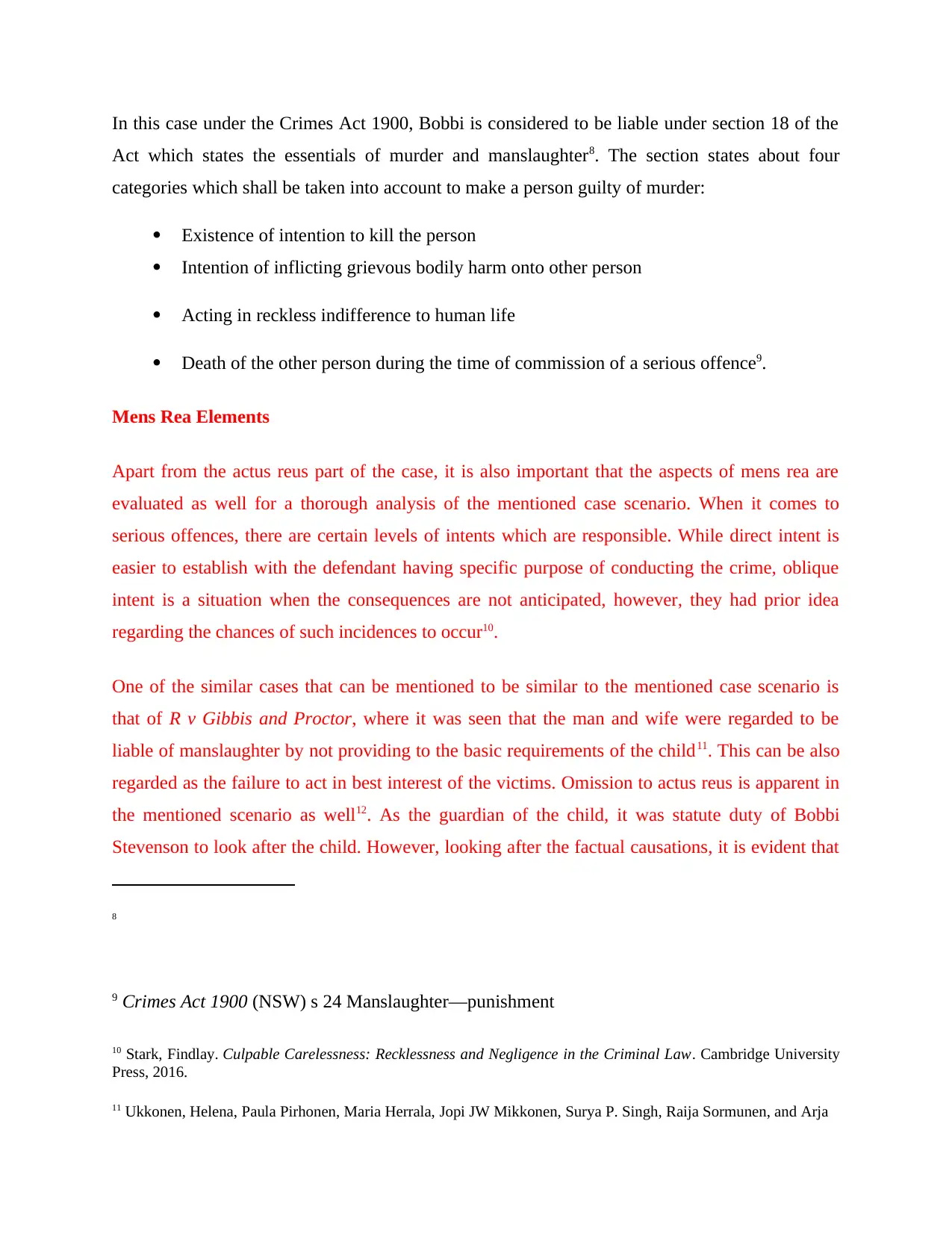
In this case under the Crimes Act 1900, Bobbi is considered to be liable under section 18 of the
Act which states the essentials of murder and manslaughter8. The section states about four
categories which shall be taken into account to make a person guilty of murder:
Existence of intention to kill the person
Intention of inflicting grievous bodily harm onto other person
Acting in reckless indifference to human life
Death of the other person during the time of commission of a serious offence9.
Mens Rea Elements
Apart from the actus reus part of the case, it is also important that the aspects of mens rea are
evaluated as well for a thorough analysis of the mentioned case scenario. When it comes to
serious offences, there are certain levels of intents which are responsible. While direct intent is
easier to establish with the defendant having specific purpose of conducting the crime, oblique
intent is a situation when the consequences are not anticipated, however, they had prior idea
regarding the chances of such incidences to occur10.
One of the similar cases that can be mentioned to be similar to the mentioned case scenario is
that of R v Gibbis and Proctor, where it was seen that the man and wife were regarded to be
liable of manslaughter by not providing to the basic requirements of the child11. This can be also
regarded as the failure to act in best interest of the victims. Omission to actus reus is apparent in
the mentioned scenario as well12. As the guardian of the child, it was statute duty of Bobbi
Stevenson to look after the child. However, looking after the factual causations, it is evident that
8
9 Crimes Act 1900 (NSW) s 24 Manslaughter—punishment
10 Stark, Findlay. Culpable Carelessness: Recklessness and Negligence in the Criminal Law. Cambridge University
Press, 2016.
11 Ukkonen, Helena, Paula Pirhonen, Maria Herrala, Jopi JW Mikkonen, Surya P. Singh, Raija Sormunen, and Arja
Act which states the essentials of murder and manslaughter8. The section states about four
categories which shall be taken into account to make a person guilty of murder:
Existence of intention to kill the person
Intention of inflicting grievous bodily harm onto other person
Acting in reckless indifference to human life
Death of the other person during the time of commission of a serious offence9.
Mens Rea Elements
Apart from the actus reus part of the case, it is also important that the aspects of mens rea are
evaluated as well for a thorough analysis of the mentioned case scenario. When it comes to
serious offences, there are certain levels of intents which are responsible. While direct intent is
easier to establish with the defendant having specific purpose of conducting the crime, oblique
intent is a situation when the consequences are not anticipated, however, they had prior idea
regarding the chances of such incidences to occur10.
One of the similar cases that can be mentioned to be similar to the mentioned case scenario is
that of R v Gibbis and Proctor, where it was seen that the man and wife were regarded to be
liable of manslaughter by not providing to the basic requirements of the child11. This can be also
regarded as the failure to act in best interest of the victims. Omission to actus reus is apparent in
the mentioned scenario as well12. As the guardian of the child, it was statute duty of Bobbi
Stevenson to look after the child. However, looking after the factual causations, it is evident that
8
9 Crimes Act 1900 (NSW) s 24 Manslaughter—punishment
10 Stark, Findlay. Culpable Carelessness: Recklessness and Negligence in the Criminal Law. Cambridge University
Press, 2016.
11 Ukkonen, Helena, Paula Pirhonen, Maria Herrala, Jopi JW Mikkonen, Surya P. Singh, Raija Sormunen, and Arja
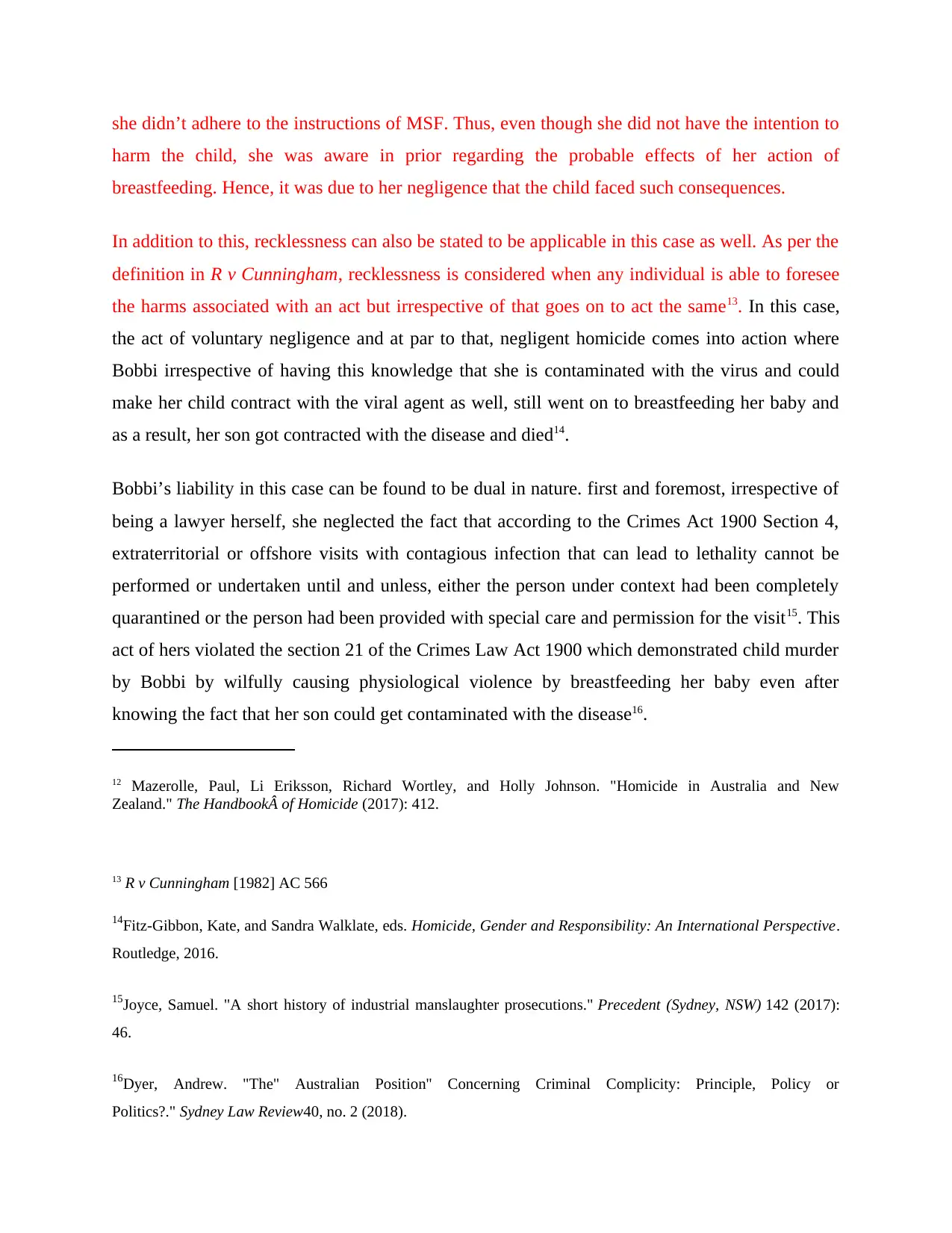
she didn’t adhere to the instructions of MSF. Thus, even though she did not have the intention to
harm the child, she was aware in prior regarding the probable effects of her action of
breastfeeding. Hence, it was due to her negligence that the child faced such consequences.
In addition to this, recklessness can also be stated to be applicable in this case as well. As per the
definition in R v Cunningham, recklessness is considered when any individual is able to foresee
the harms associated with an act but irrespective of that goes on to act the same13. In this case,
the act of voluntary negligence and at par to that, negligent homicide comes into action where
Bobbi irrespective of having this knowledge that she is contaminated with the virus and could
make her child contract with the viral agent as well, still went on to breastfeeding her baby and
as a result, her son got contracted with the disease and died14.
Bobbi’s liability in this case can be found to be dual in nature. first and foremost, irrespective of
being a lawyer herself, she neglected the fact that according to the Crimes Act 1900 Section 4,
extraterritorial or offshore visits with contagious infection that can lead to lethality cannot be
performed or undertaken until and unless, either the person under context had been completely
quarantined or the person had been provided with special care and permission for the visit15. This
act of hers violated the section 21 of the Crimes Law Act 1900 which demonstrated child murder
by Bobbi by wilfully causing physiological violence by breastfeeding her baby even after
knowing the fact that her son could get contaminated with the disease16.
12 Mazerolle, Paul, Li Eriksson, Richard Wortley, and Holly Johnson. "Homicide in Australia and New
Zealand." The Handbook of Homicide (2017): 412.
13 R v Cunningham [1982] AC 566
14Fitz-Gibbon, Kate, and Sandra Walklate, eds. Homicide, Gender and Responsibility: An International Perspective.
Routledge, 2016.
15Joyce, Samuel. "A short history of industrial manslaughter prosecutions." Precedent (Sydney, NSW) 142 (2017):
46.
16Dyer, Andrew. "The" Australian Position" Concerning Criminal Complicity: Principle, Policy or
Politics?." Sydney Law Review40, no. 2 (2018).
harm the child, she was aware in prior regarding the probable effects of her action of
breastfeeding. Hence, it was due to her negligence that the child faced such consequences.
In addition to this, recklessness can also be stated to be applicable in this case as well. As per the
definition in R v Cunningham, recklessness is considered when any individual is able to foresee
the harms associated with an act but irrespective of that goes on to act the same13. In this case,
the act of voluntary negligence and at par to that, negligent homicide comes into action where
Bobbi irrespective of having this knowledge that she is contaminated with the virus and could
make her child contract with the viral agent as well, still went on to breastfeeding her baby and
as a result, her son got contracted with the disease and died14.
Bobbi’s liability in this case can be found to be dual in nature. first and foremost, irrespective of
being a lawyer herself, she neglected the fact that according to the Crimes Act 1900 Section 4,
extraterritorial or offshore visits with contagious infection that can lead to lethality cannot be
performed or undertaken until and unless, either the person under context had been completely
quarantined or the person had been provided with special care and permission for the visit15. This
act of hers violated the section 21 of the Crimes Law Act 1900 which demonstrated child murder
by Bobbi by wilfully causing physiological violence by breastfeeding her baby even after
knowing the fact that her son could get contaminated with the disease16.
12 Mazerolle, Paul, Li Eriksson, Richard Wortley, and Holly Johnson. "Homicide in Australia and New
Zealand." The Handbook of Homicide (2017): 412.
13 R v Cunningham [1982] AC 566
14Fitz-Gibbon, Kate, and Sandra Walklate, eds. Homicide, Gender and Responsibility: An International Perspective.
Routledge, 2016.
15Joyce, Samuel. "A short history of industrial manslaughter prosecutions." Precedent (Sydney, NSW) 142 (2017):
46.
16Dyer, Andrew. "The" Australian Position" Concerning Criminal Complicity: Principle, Policy or
Politics?." Sydney Law Review40, no. 2 (2018).
⊘ This is a preview!⊘
Do you want full access?
Subscribe today to unlock all pages.

Trusted by 1+ million students worldwide
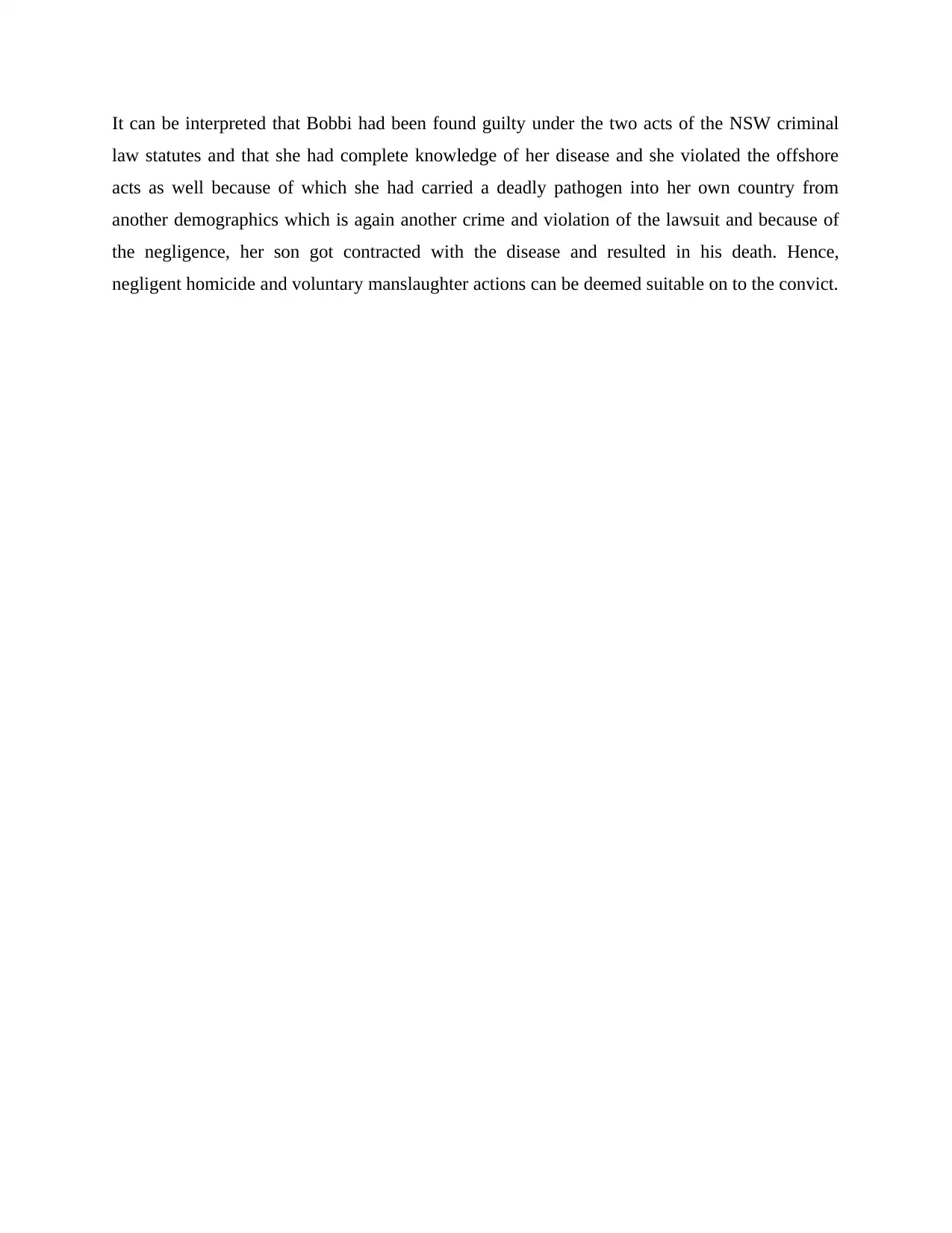
It can be interpreted that Bobbi had been found guilty under the two acts of the NSW criminal
law statutes and that she had complete knowledge of her disease and she violated the offshore
acts as well because of which she had carried a deadly pathogen into her own country from
another demographics which is again another crime and violation of the lawsuit and because of
the negligence, her son got contracted with the disease and resulted in his death. Hence,
negligent homicide and voluntary manslaughter actions can be deemed suitable on to the convict.
law statutes and that she had complete knowledge of her disease and she violated the offshore
acts as well because of which she had carried a deadly pathogen into her own country from
another demographics which is again another crime and violation of the lawsuit and because of
the negligence, her son got contracted with the disease and resulted in his death. Hence,
negligent homicide and voluntary manslaughter actions can be deemed suitable on to the convict.
Paraphrase This Document
Need a fresh take? Get an instant paraphrase of this document with our AI Paraphraser
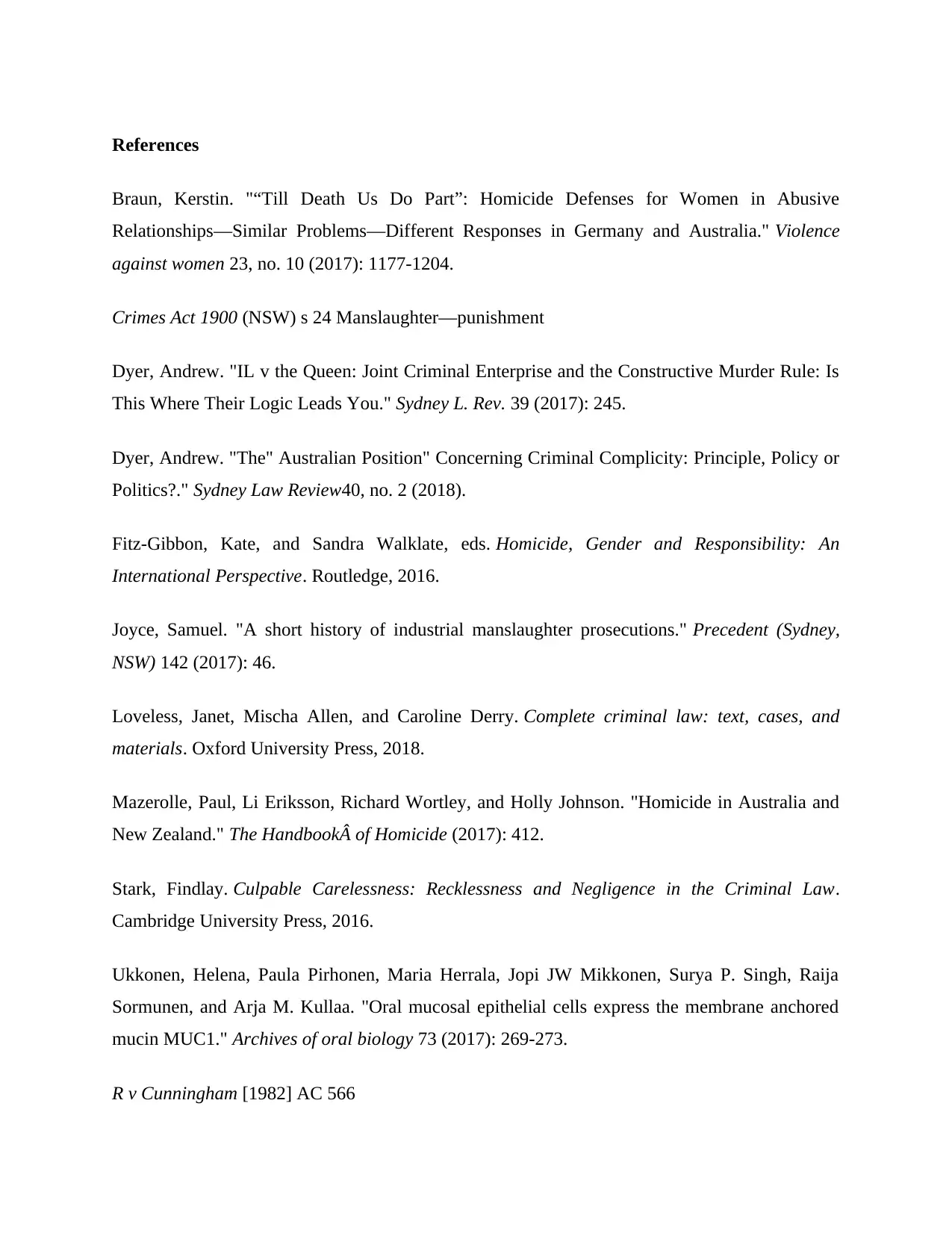
References
Braun, Kerstin. "“Till Death Us Do Part”: Homicide Defenses for Women in Abusive
Relationships—Similar Problems—Different Responses in Germany and Australia." Violence
against women 23, no. 10 (2017): 1177-1204.
Crimes Act 1900 (NSW) s 24 Manslaughter—punishment
Dyer, Andrew. "IL v the Queen: Joint Criminal Enterprise and the Constructive Murder Rule: Is
This Where Their Logic Leads You." Sydney L. Rev. 39 (2017): 245.
Dyer, Andrew. "The" Australian Position" Concerning Criminal Complicity: Principle, Policy or
Politics?." Sydney Law Review40, no. 2 (2018).
Fitz-Gibbon, Kate, and Sandra Walklate, eds. Homicide, Gender and Responsibility: An
International Perspective. Routledge, 2016.
Joyce, Samuel. "A short history of industrial manslaughter prosecutions." Precedent (Sydney,
NSW) 142 (2017): 46.
Loveless, Janet, Mischa Allen, and Caroline Derry. Complete criminal law: text, cases, and
materials. Oxford University Press, 2018.
Mazerolle, Paul, Li Eriksson, Richard Wortley, and Holly Johnson. "Homicide in Australia and
New Zealand." The Handbook of Homicide (2017): 412.
Stark, Findlay. Culpable Carelessness: Recklessness and Negligence in the Criminal Law.
Cambridge University Press, 2016.
Ukkonen, Helena, Paula Pirhonen, Maria Herrala, Jopi JW Mikkonen, Surya P. Singh, Raija
Sormunen, and Arja M. Kullaa. "Oral mucosal epithelial cells express the membrane anchored
mucin MUC1." Archives of oral biology 73 (2017): 269-273.
R v Cunningham [1982] AC 566
Braun, Kerstin. "“Till Death Us Do Part”: Homicide Defenses for Women in Abusive
Relationships—Similar Problems—Different Responses in Germany and Australia." Violence
against women 23, no. 10 (2017): 1177-1204.
Crimes Act 1900 (NSW) s 24 Manslaughter—punishment
Dyer, Andrew. "IL v the Queen: Joint Criminal Enterprise and the Constructive Murder Rule: Is
This Where Their Logic Leads You." Sydney L. Rev. 39 (2017): 245.
Dyer, Andrew. "The" Australian Position" Concerning Criminal Complicity: Principle, Policy or
Politics?." Sydney Law Review40, no. 2 (2018).
Fitz-Gibbon, Kate, and Sandra Walklate, eds. Homicide, Gender and Responsibility: An
International Perspective. Routledge, 2016.
Joyce, Samuel. "A short history of industrial manslaughter prosecutions." Precedent (Sydney,
NSW) 142 (2017): 46.
Loveless, Janet, Mischa Allen, and Caroline Derry. Complete criminal law: text, cases, and
materials. Oxford University Press, 2018.
Mazerolle, Paul, Li Eriksson, Richard Wortley, and Holly Johnson. "Homicide in Australia and
New Zealand." The Handbook of Homicide (2017): 412.
Stark, Findlay. Culpable Carelessness: Recklessness and Negligence in the Criminal Law.
Cambridge University Press, 2016.
Ukkonen, Helena, Paula Pirhonen, Maria Herrala, Jopi JW Mikkonen, Surya P. Singh, Raija
Sormunen, and Arja M. Kullaa. "Oral mucosal epithelial cells express the membrane anchored
mucin MUC1." Archives of oral biology 73 (2017): 269-273.
R v Cunningham [1982] AC 566
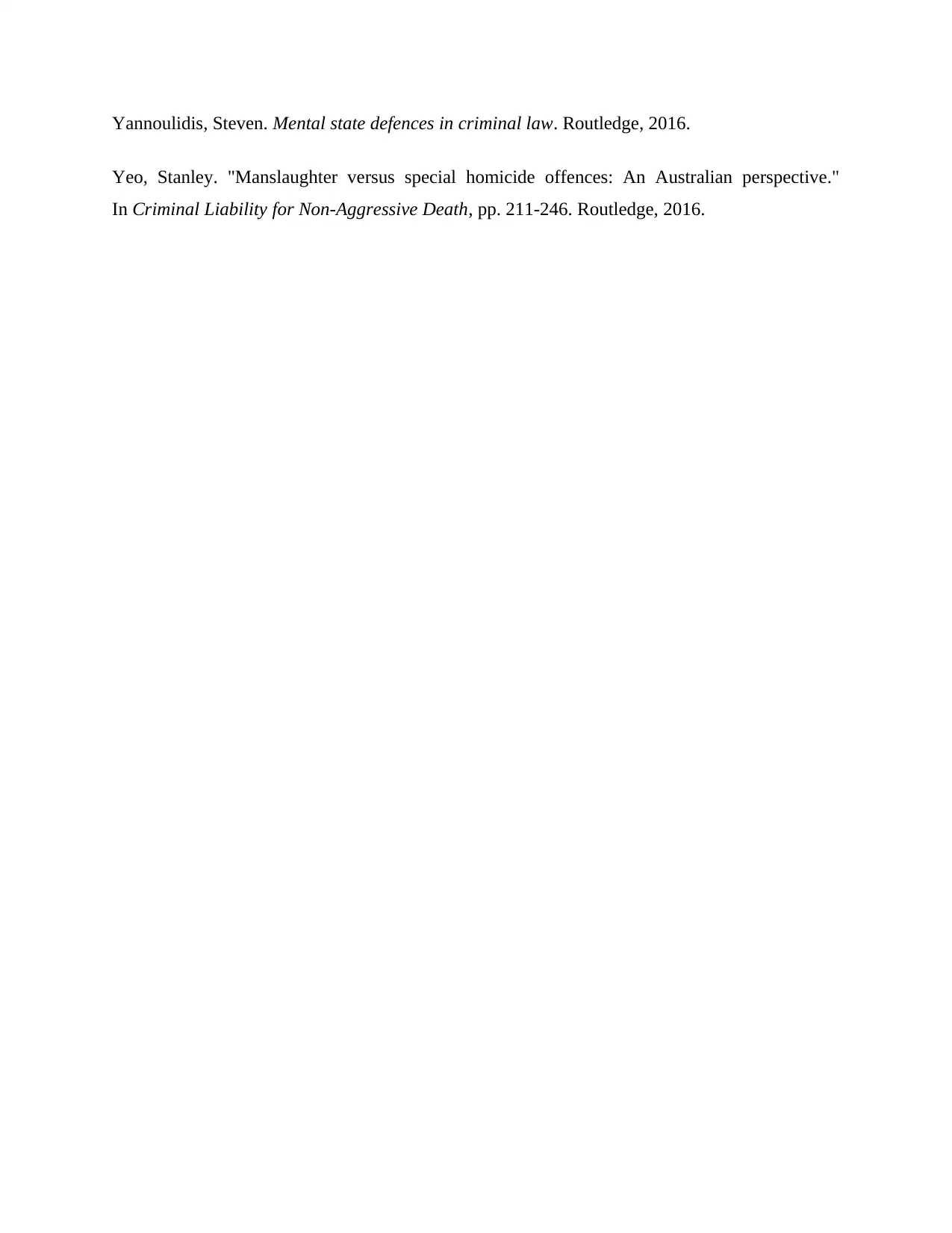
Yannoulidis, Steven. Mental state defences in criminal law. Routledge, 2016.
Yeo, Stanley. "Manslaughter versus special homicide offences: An Australian perspective."
In Criminal Liability for Non-Aggressive Death, pp. 211-246. Routledge, 2016.
Yeo, Stanley. "Manslaughter versus special homicide offences: An Australian perspective."
In Criminal Liability for Non-Aggressive Death, pp. 211-246. Routledge, 2016.
⊘ This is a preview!⊘
Do you want full access?
Subscribe today to unlock all pages.

Trusted by 1+ million students worldwide
1 out of 9
Related Documents
Your All-in-One AI-Powered Toolkit for Academic Success.
+13062052269
info@desklib.com
Available 24*7 on WhatsApp / Email
![[object Object]](/_next/static/media/star-bottom.7253800d.svg)
Unlock your academic potential
Copyright © 2020–2025 A2Z Services. All Rights Reserved. Developed and managed by ZUCOL.





